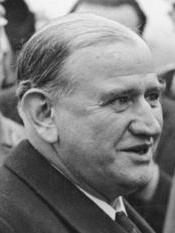| ||||||||||||||||||||||||||||
Edouard Daladier (18 June 1884 – 10 October 1970) served as Prime Minister of France on three separate occasions between 1933 and 1940. He also served as Minister of War at the outset of World War II. Following the fall of France, he fled to Morocco on the assumption that the government would continue the struggle from there, but was arrested by the Vichy regime. He was interred at Germany's Buchenwald concentration camp and at Itter Castle in France. He was released in 1944 as the Allied Forces liberated France. After the war he continued to participate in French politics.
He is perhaps best remembered for representing France at the Munich Conference, at which he approved letting Germany seize control of the Sudetenland in Czechoslovakia.
Edouard Daladier in The War That Came Early[]
Edouard Daladier represented France at the Munich Conference. Though France, like Britain, was obligated by treaty to protect Czechoslovakia from German aggression, Daladier and British Prime Minister Neville Chamberlain were desperate to avoid the need to fight another war against Germany. Thus, both were prepared to allow Adolf Hitler to seize the Sudetenland unchallenged. However, when news of the assassination of Konrad Henlein reached the conference, Daladier and Chamberlain both assumed Hitler had arranged the event to give himself an excuse to invade Czechoslovakia. He had not, but he seized upon the opportunity to do so anyway, prompting France and Britain to go to war with Germany.[1]
| The War That Came Early POD: July 20, 1936; Relevant POD: September 29, 1938 | |
| Appearance(s): | Contemporary references throughout |
| Type of Appearance: | Direct (Hitler's War) |
Under Daladier, French troops did cross over into German territory in October 1938. French military intelligence was convinced that Germany was far stronger militarily than it actually was, so little fighting was done on German soil.[2] Once Czechoslovakia was subdued, Germany turned on France with a vengeance. Simultaneously, Germany invaded the Low Countries before invading France proper in an attempt to implement the Schlieffen Plan, much as it had in 1914. Throughout much the remainder of 1938 and into the Spring of 1939, it did appear that the Germans would successfully take Paris. Paris proper was even subject to aerial bombardment. However, Anglo-French forces were able to finally bring the German drive to halt in April 1939.
Daladier was often depicted as a puppet of Jewish interests in German propaganda.[3]
After nearly two years of warfare which saw only the slowest of gains in forcing German troops out of France, as well as the loss of Norway to German occupation, Chamberlain and Daladier accepted a mid-1940 proposal made by Deputy Führer Rudolf Hess in which both Britain and France ended their war with Germany, and joined Germany's war against the Soviet Union.[4] By the end of 1940, French troops were fighting in Poland and in the Soviet Union proper.[5] This move was not universally popular.[6]
Still, the new coalition was quite successful as 1940 passed into 1941. By mid-1941, French troops had pushed deep into Russian territory. However, Daladier made certain to keep his country's options open. In the Spring of 1941, the British military, in an unprecedented move, overthrew the government of Neville Chamberlain's successor, Sir Horace Wilson[7] The interim government withdrew troops from Soviet territory, and declared war on Germany.[8]
Daladier did not follow immediately follow suit. Indeed, for much of the rest of the year, Britain was concerned that Hitler might convince Daladier to attack the U.K.[9] France did not follow this plan. Instead, Daladier continued France's war in Russia, while simultaneously taking steps in the event of renewed war with Germany. In the summer, France began supplying the Spanish Republic again.[10] Closer to home, Daladier ordered the Maginot Line expanded from the Belgian border to the English Channel. The move was not unnoticed.[11]
Daladier also began negotiations with the British[12] and the Soviet Union.[13] By the end of 1941, negotiations had been completed, and France ceased to be at war with the USSR. This became official one night when French forces launched green flares into the sky. French troops, despite German efforts, quickly surrendered en masse to the Soviets as part of the political realignment.[14] They were then returned to French territory.
With the dissolution of the Hess Agreement, Daladier and the British government concentrated on defeating Germany in Europe. While the Allies made substantial gains in the Low Countries, in the East, Soviet troops pushed through Ukraine towards Poland. The approaching Allied pincers continued to advance gradually but steadily throughout the next year and a half, eroding confidence in Hitler in Germany.
After Hitler declared war on the United States in March 1944,[15] several military leaders formed the Committee for the Salvation of the German Nation, with General Heinz Guderian as their leader., successfully assassinated Hitler in April.[16] A civil war broke out in Germany almost immediately. Several of Hitler's would-be successors were arrested or killed. Ultimately, Guderian and the Committee triumphed, and fighting ceased on all fronts in Europe.[17]
Germany negotiated a peace treaty with Britain, France and the Soviet Union. (The U.S. also participated in the negotiations, but in a very junior capacity in light of the lack of U.S. troops in Europe.) Germany agreed to withdraw from the Low Countries, Denmark and Norway along with the areas of the USSR it still occupied (mostly Byelorussia and Ukraine).[18] In return, the pre-war annexation of Austria was confirmed and the Sudetenland annexation which was the casus belli was allowed. Czechoslovakia was broken up into the puppet state of Slovakia and the Protectorate of Bohemia and Moravia.[19]
Thus, Daladier did steer his country to something like victory, but it was a hollow one, with little gain. While Hitler was removed as a threat, Germany had gained territory and remained militarily powerful, and therefore, a possible threat to France.
Edouard Daladier in Joe Steele[]
| Joe Steele POD: 1878; Relevant POD: July, 1932 | |
| Novel or Story?: | Novel only |
| Type of Appearance: | Contemporary reference |
In September 1938, despite pledges of support from U.S. President Joe Steele and Soviet leader Leon Trotsky, French Premier Edouard Daladier and his British counterpart Neville Chamberlain agreed to transfer the Sudetenland to Germany after repeated demands by Adolf Hitler.[20]
References[]
- ↑ Hitler's War, pg.s 8-16.
- ↑ Ibid., e.g., pgs. 36-39.
- ↑ Ibid., pg. 377.
- ↑ The Big Switch, generally, see pgs., 200-220.
- ↑ Ibid., generally, see pg. 312.
- ↑ Ibid.
- ↑ Coup d'Etat, pgs. 152-154.
- ↑ Ibid., pg. 187.
- ↑ Ibid., pg. 189.
- ↑ Ibid., pgs. 205-206.
- ↑ Ibid., pg. 233.
- ↑ Ibid., pg. 386.
- ↑ Ibid.
- ↑ Ibid. pgs. 389-395
- ↑ Last Orders pgs. 269-70.
- ↑ Ibid., pg. 300.
- ↑ Ibid., pg. 382.
- ↑ Ibid, pg. 318.
- ↑ Ibid, pgs. 341-343.
- ↑ Joe Steele, pgs. 202-203.
| Political offices (OTL) | ||
|---|---|---|
| Preceded by Joseph Paul-Boncour |
President of the Council (Prime Minister) of France 1933 |
Succeeded by Albert Sarraut |
| Preceded by Camille Chautemps |
President of the Council (Prime Minister) of France 1934 |
Succeeded by Gaston Doumergue |
| Preceded by Léon Blum |
President of the Council (Prime Minister) of France 1938-1940 |
Succeeded by Paul Reynaud |
| Political offices (The War That Came Early) | ||
| Preceded by Léon Blum |
President of the Council (Prime Minister) of France 1938-19?? |
Succeeded by Incumbent at series' end, 1944 |
| |||||||||||||||||||
| ||||||||||||||||||||||







